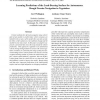Free Online Productivity Tools
i2Speak
i2Symbol
i2OCR
iTex2Img
iWeb2Print
iWeb2Shot
i2Type
iPdf2Split
iPdf2Merge
i2Bopomofo
i2Arabic
i2Style
i2Image
i2PDF
iLatex2Rtf
Sci2ools
FSR
2003
Springer
2003
Springer
Learning Predictions of the Load-Bearing Surface for Autonomous Rough-Terrain Navigation in Vegetation
Current methods for off-road navigation using vehicle and terrain models to predict future vehicle response are limited by the accuracy of the models they use and can suffer if the world is unknown or if conditions change and the models become inaccurate. In this paper, an adaptive approach is presented that closes the loop around the vehicle predictions. This approach is applied to an autonomous vehicle driving through unknown terrain with varied vegetation. Features are extracted from range points from forward looking sensors. These features are used by a locally weighted learning module to predict the load-bearing surface, which is often hidden by vegetation. The true surface is then found when the vehicle drives over that area, and this feedback is used to improve the model. Results using real data show improved predictions of the load-bearing surface and successful adaptation to changing conditions.
| Added | 06 Jul 2010 |
| Updated | 06 Jul 2010 |
| Type | Conference |
| Year | 2003 |
| Where | FSR |
| Authors | Carl Wellington, Anthony Stentz |
Comments (0)

